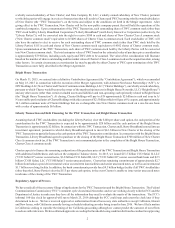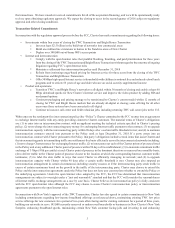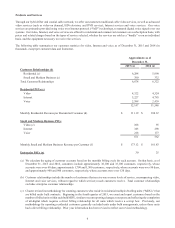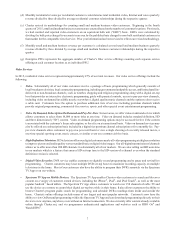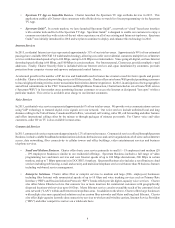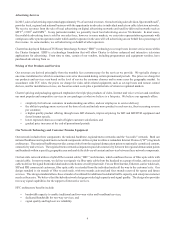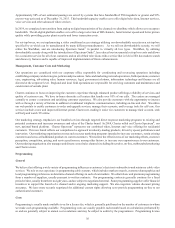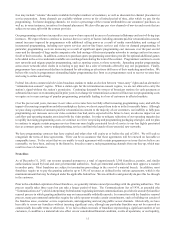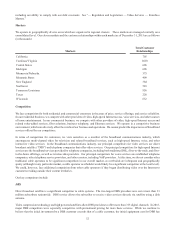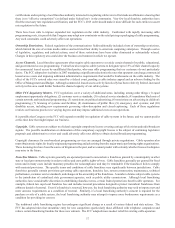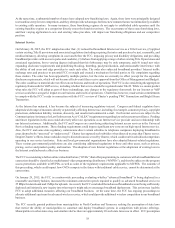Charter 2015 Annual Report Download - page 26
Download and view the complete annual report
Please find page 26 of the 2015 Charter annual report below. You can navigate through the pages in the report by either clicking on the pages listed below, or by using the keyword search tool below to find specific information within the annual report.11
fees may include “volume” discounts available for higher numbers of customers, as well as discounts for channel placement or
service penetration. Some channels are available without cost to us for a limited period of time, after which we pay for the
programming. For home shopping channels, we receive a percentage of the revenue attributable to our customers’ purchases, as
well as, in some instances, incentives for channel placement. We also offer pay per view channels of movies and events that are
subject to revenue split with the content provider.
Our programming costs have increased in every year we have operated in excess of customary inflationary and cost-of-living type
increases. We expect them to continue to increase due to a variety of factors including amounts paid for retransmission consent,
annual increases imposed by programmers with additional selling power as a result of media consolidation, and carriage of
incremental programming, including new sports services and on-line linear services and video on demand programming. In
particular, programming costs are increasing as a result of significant sports programming cost increases over the past several
years and the demands of large media companies who link carriage of their most popular networks to carriage and cost increases
for all of their networks. In addition, contracts to purchase sports programming sometimes provide for optional additional games
to be added to the service and made available on a surcharge basis during the term of the contract. Programmers continue to create
new networks and migrate popular programming, such as sporting events, to those networks. Spreading popular programming
across more networks often results in us having to pay more for a suite of networks offered by any one programmer. Finally,
programmers have experienced declines in demand for advertising as advertisers shift more of their marketing spend online. We
believe this results in programmers demanding higher programming fees from us as programmers seek to recover revenue they
are losing to online advertising.
Federal law allows commercial television broadcast stations to make an election between “must-carry” rights and an alternative
“retransmission-consent” regime. When a station opts for the retransmission-consent regime, we are not allowed to carry the
station’s signal without the station’s permission. Continuing demands by owners of broadcast stations for cash payments at
substantial increases over amounts paid in prior years in exchange for retransmission consent will increase our programming costs
or require us to cease carriage of popular programming, potentially leading to a loss of customers in affected markets.
Over the past several years, increases in our video service rates have not fully offset increasing programming costs, and with the
impact of increasing competition and other marketplace factors, we do not expect them to do so in the foreseeable future. Although
we pass along a portion of amounts paid for retransmission consent to the majority of our customers, our inability to fully pass
programming cost increases on to our video customers has had, and is expected in the future to have, an adverse impact on our
cash flow and operating margins associated with the video product. In order to mitigate reductions of our operating margins due
to rapidly increasing programming costs, we continue to review our pricing and programming packaging strategies, and we plan
to continue to migrate certain program services from our more highly penetrated levels of service to our less highly penetrated
tiers as contracts permit, remove underperforming services and limit the launch of non-essential, new networks.
We have programming contracts that have expired and others that will expire at or before the end of 2016. We will seek to
renegotiate the terms of these agreements. There can be no assurance that these agreements will be renewed on favorable or
comparable terms. To the extent that we are unable to reach agreement with certain programmers on terms that we believe are
reasonable, we have been, and may in the future be, forced to remove such programming channels from our line-up, which may
result in a loss of customers.
Franchises
As of December 31, 2015, our systems operated pursuant to a total of approximately 3,300 franchises, permits, and similar
authorizations issued by local and state governmental authorities. Such governmental authorities often must approve a transfer
to another party. Most franchises are subject to termination proceedings in the event of a material breach. In addition, most
franchises require us to pay the granting authority up to 5.0% of revenues as defined in the various agreements, which is the
maximum amount that may be charged under the applicable federal law. We are entitled to and generally do pass this fee through
to the customer.
Prior to the scheduled expiration of most franchises, we generally initiate renewal proceedings with the granting authorities. This
process usually takes three years but can take a longer period of time. The Communications Act of 1934, as amended (the
“Communications Act”), which is the primary federal statute regulating interstate communications, provides for an orderly franchise
renewal process in which granting authorities may not unreasonably withhold renewals. In connection with the franchise renewal
process, many governmental authorities require the cable operator to make certain commitments, such as building out certain of
the franchise areas, customer service requirements, and supporting and carrying public access channels. Historically, we have
been able to renew our franchises without incurring significant costs, although any particular franchise may not be renewed on
commercially favorable terms or otherwise. If we fail to obtain renewals of franchises representing a significant number of our
customers, it could have a material adverse effect on our consolidated financial condition, results of operations, or our liquidity,



